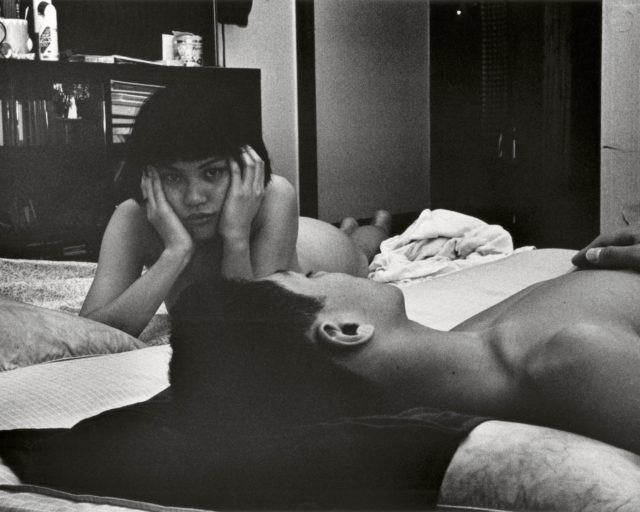Back to the Future
.

Kris Graves, Jessica and Keith #2, 2016
Courtesy the artist
Future Isms, an exhibition currently on view at Seattle’s Glass Box Gallery, considers the legacy of visual arts in positing techo-cultural visions of the future—Star Trek’s handheld communicators that foretold smartphones, for example—and what present assertions may suggest about what lies in store for us. I recently spoke with Jon Feinstein, the exhibition’s curator, about virtual exhibition practice as a possible “future ism,” photography as a former “future medium,” and the overlap of visual art and science fiction literature as experimental spaces where ideas of the unknown, utopian, and dystopian alike, filter into our cultural lexicon.

Anastasia Samoylova, Lightnings, 2014
Courtesy the artist
Roula Seikaly: Where did the idea for Future Isms originate?
Jon Feinstein: I’d been wanting to organize a show about the future for a few years. I’d seen a lot of photo-based work about this popping up—such as Jade Doskow’s Lost Utopias (2016)—and I wanted to put my own curatorial angle on it. When the 2016 U.S. presidential election started stirring tension and divisions in this country and beyond, it felt like there was a new way to approach this. We put out the call for work a week or two before Election Day with the idea, initially, that this was going to be the final Humble Arts Foundation online exhibition for 2016.
At the same time, I was working on an unrelated idea for a brick and mortar show at Glass Box Gallery. But when the election results came in, a new sense of urgency came to it all, so I pitched the idea to Glass Box’s director Weston Jandacka. He was excited to change course. The title, Future Isms was borrowed from the title of an early record from Milemarker, one of my favorite bands in my late teens and early 20s. They added keyboards and electronic elements to late-’90s punk/hardcore; I think there are a lot of parallels between their music and lyrics and how I was thinking about this show. Coincidentally, it turns out that the band’s guitar player happened to be a student of Elin O’Hara Slavick, who has a piece in the online version of our exhibition.
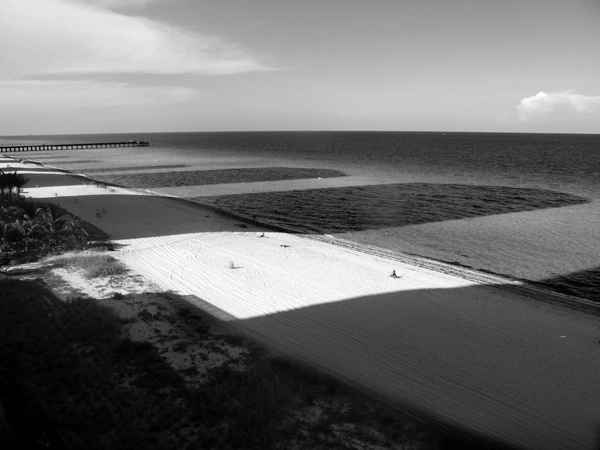
Orestes Gonzalez, Dark Shadows from the Trump Towers Invade the Beach, 2012
Courtesy the artist
Seikaly: How do you define the term “future ism”?
Feinstein: For me it’s about “pseudo-futures,” which could have been an alternate title for the exhibition. It’s about representations of the future that borrow from, and riff on past, often expired ideas about the future in classic literature and media, and make them new—because time is continuous. Michael Marcelle, one of the exhibiting artists, references the cloying syntax of old science fiction movies, the premonitions of the future in any work of art, and literature that will ultimately become outdated and feel like a thing of the past.
Seikaly: What were you looking for in the work that you included in the exhibition?
Feinstein: I wanted to avoid a show that screamed “SCIENCE FICTION.” That’s a component, but I wanted things to be a bit more mysterious, unsettling, and less literal. There are no images of steampunk gear-goggles, for example. My intent was for individual images to serve as little nods or chapter markers, leading to building feelings of anguish, and the ambiguity of what might come. The work ranges from straightforward, almost typological cityscapes to collage and humorous, animated gifs.
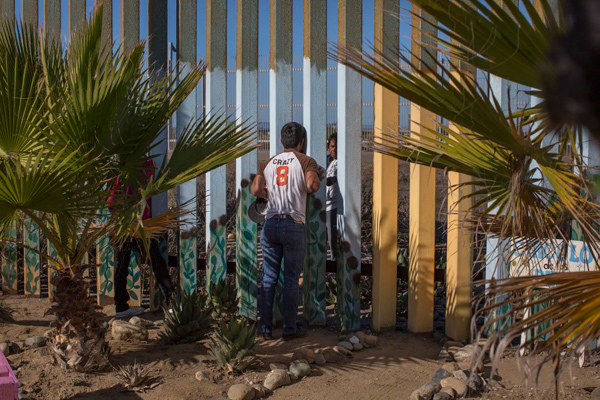
Griselda San Martin, Through The Wall, 2015
Courtesy the artist
Seikaly: Can the anguish and ambiguity about our political climate and what the future holds be a generative creative experience?
Feinstein: One idea that has come up in many conversations with artists lately—those in the show, and beyond—is that art can be generative, that it can take the craziness of where the world is and where it’s going and use it to fuel the creative process. The photographer Serrah Russell just completed a series called 100 Days of Collage (2016–17), three pieces of which were included in the show. For one hundred days after the election, she made a collage each day, responding viscerally to the strangely unfolding future.
Seikaly: The first photographic processes evolved in the mid-nineteenth during the Industrial Revolution. I think it can be argued that the mechanistic aspect of photography aligned it with future-focused developments in a rapidly modernizing world. Do you think photography is still a medium of the future?
Feinstein: As it relates to this show, I think photography, when interpreted as a technology, could be seen, by some, as a medium of the past. While we might not want to admit it, our iPhones are competing with Digital SLRs, which only a couple years ago outdated film for a majority of photographers. Everything evolves at light speed. On some level, I look at photography less as its own medium of the future, and more as a continuous tool that is constantly taking on new forms and hosts. I don’t think this necessarily means that photography is expiring as an artistic medium, but our understanding and application of light-sensitive imagery—still, moving, or holographic—keeps shifting. I think what’s important is that with making photo-based art, our ideas stay focused, yet malleable so that we can continue having interesting visual conversations.

Daniel Temkin, Saratoga, NY, 2016
Courtesy the artist
Seikaly: Could you talk about the exhibitions you’ve curated online and why Future Isms was pared down and presented at Glass Box?
Feinstein: I’ve been producing exhibitions online with Humble’s co-founder Amani Olu since 2005. Our no-frills project called “group show dot com” quickly evolved into physical exhibitions, and a range of other grant and publishing projects. For years, our online shows had no themes; we liked the challenge of drawing relationships between works that appeared unrelated on the surface. After a brief hiatus in 2013, we re-launched to show quarterly exhibitions around a more defined theme. Our first show in this new format was called Tough Turf: New Directions in Street Photography. It was one of the first street photography shows that included a disclaimer that digitally manipulated images would be accepted. Historically, any kind of manipulation in street photography has been a huge taboo, so we wanted to explore these images. The purists on various street photo blogs called us morons and fools, and we kind of enjoyed that.
Many of our online shows include over fifty images. The online version of Future Isms includes eighty. Even with generous access to two floors at Glass Box Gallery, that would be too many to include with room for the work to breathe. Also, I wanted to include some installations by artists who are local to Seattle, including Max Cleary’s Guy Debord-inspired photography-based sculptures, and Parsley Steinweiss’s photo paper origami fortunetellers.
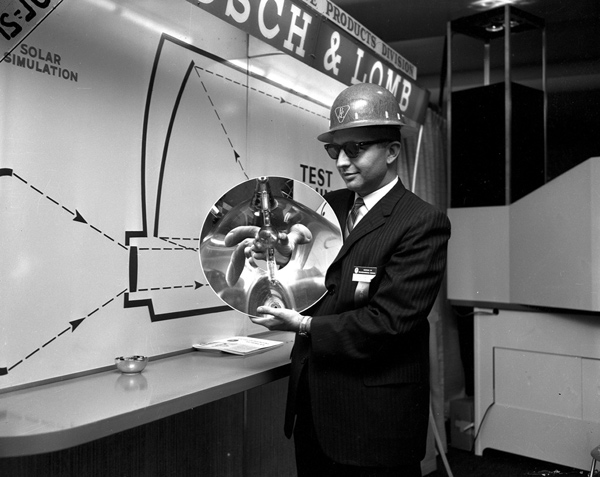
Ben Alper, Bausch and Lomb
Courtesy of the artist and The Archival Impulse
Seikaly: Are online exhibitions a “future ism”? Do you think there will come a time when virtual exhibitions will successfully challenge presentations in museums or other arts spaces?
Feinstein: I see online exhibitions less as a challenge and more as a way of complementing the experience of seeing art in person, and democratizing who has access to see and participate. Online exhibitions can be more crowded in terms of included images, and often more wide ranging, but at least it allows similar access to people in Nebraska, Nigeria, Berlin and New York City.
Seikaly: Could you describe the various visual strategies the exhibiting artists apply in realizing this work? Where do you see the theme of the exhibition illustrated?
Feinstein: The artists included come from a range of backgrounds and address the open-ended concept of the show with a variety of approaches. Joe Rudko, for example, takes a deeply personal approach using a simple yet chaotic collage of vernacular photographs that spell out “The Weird Feelings Inside of Me” to capture his sense of anxiety about the changing world. Likely one of the more directly political sets of images in the show, Orestes Gonzalez, using a more straightforward process, made a series of photographs of the shadows cast by Trump hotels on a Miami beach, pushing the sunbathers to chase the sun’s waning rays. Made more than a decade ago, Gonzalez’s work is foreboding and current. While Gonzalez and Rudko’s work, like many artists in the show, are grounded in discomfort, some artists tread into more playful territory. Anastasia Samoylova, for example, creates tactile sculptures from digital stock images and then re-photographs them. Her work fuses the history of landscape photography with how we experience the landscape today, largely on screens, in a way that she describes as “bending space and time.” They are lighter, less brooding, and more aligned with a fantasy of how we experience the world.
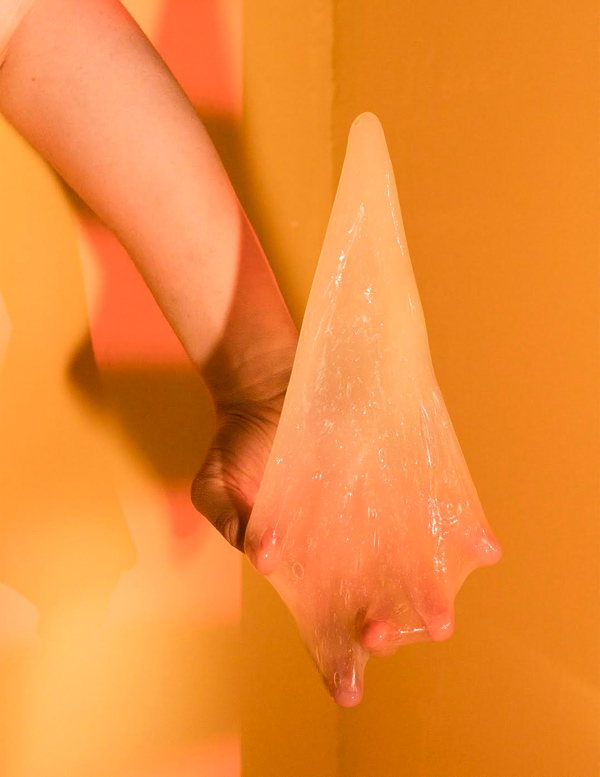
Michael Marcelle, Orange Still Life, 2016
Courtesy the artist
Seikaly: Do you know of any “future” projects that the artists are working on? When this exhibition closes, it will be in the past, but are there any artists in the exhibition working on projects with an eye to the future?
Feinstein: Daniel Temkin, whose image from Straightened Trees (2016) was one of the first I selected for the exhibition, is working on a new series called The Unprintable. These are digital images that he builds with contrasting colors. Arranged in patterns that are complex at both close and far distances, the images frustrate the interpolation algorithms that map the grid of the image to the pixels of the screen where they are viewed. Zooming in or out, the image seems to change dramatically. Instead of the image itself, we see artifacts of its inability to render at each scale. While not literally “photographic,” it builds on Temkin’s practice of using technology to re-code how we see.
Michael Marcelle’s images are part of an ongoing series, Red Strawberry, which explores the visual limitations of science fiction, specifically its overly saturated, nearly hallucinogenic hues. In Marcelle’s words, “it’s both primitive and futuristic…or maybe a vivid interpretation of the present,” building on an earlier series that used re-created horror tropes as a metaphor for the destruction of Hurricane Sandy.
Griselda San Martin is expanding upon her series of families at the U.S.-Mexican border. The photograph we included in Future Isms shows a couple as they try to embrace through the wall. Looking forward, San Martin has begun expanding on these issues, following the fate and struggles of several undocumented families on the east coast of the United States.
Future Isms is on view at Glass Box Gallery, Seattle, through April 15, 2017.












